In the world of SUVs, the Ford Kuga and Skoda Kodiaq have emerged as two formidable contenders, each appealing to a slightly different market segment. This article aims to dissect their offerings across various parameters including technical features, performance metrics, and innovative technologies.
Ford Kuga vs Skoda Kodiaq – Differences & prices compared
Both models have their strengths – but which one suits you more?
Compare performance, efficiency, price and space directly: Ford Kuga or Skoda Kodiaq?
Engine Options and Performance
The Ford Kuga boasts a diverse range of engine options catering to a wide spectrum of preferences. Available engines include petrol, full hybrid, and plug-in hybrid configurations, generating power outputs ranging from 150 HP to an impressive 243 HP. This provides versatility for various driving styles and needs. The Kuga offers a choice of manual and automatic transmissions, with front-wheel drive and all-wheel drive variants.
On the other hand, the Skoda Kodiaq presents a mix of petrol, diesel, and hybrid options, specifically including a petrol MHEV and plug-in hybrid model. Its power range starts from 150 HP and goes up to 204 HP. The Kodiaq is equipped with a sophisticated automatic double-clutch transmission that enhances driving performance and fuel efficiency. Both SUVs demonstrate strong performance with the Ford Kuga's 0-100 km/h times between 7.3 to 9.5 seconds, while the Kodiaq ranges from 7.8 to 9.7 seconds, depending on the variant.
Fuel Efficiency and Eco-Friendliness
In terms of fuel efficiency, the Ford Kuga offers an impressive lineup of consumption figures, with the hybrid variants demonstrating remarkably low fuel usage of up to 0.9 L/100km for electric driving. The electric-only range of 69 km for Kuga’s plug-in hybrid variant adds to its eco-friendliness, making it suitable for daily commutes.
The Skoda Kodiaq, meanwhile, also emphasizes efficiency with fuel consumption ranging from 0.4 to 7.6 L/100km depending on the model. Its plug-in hybrid variant can achieve an electric range of 123 km, making it a practical choice for those who wish to minimize their carbon footprint while enjoying spacious interiors.
Interior Space and Comfort
When it comes to interior space, the Skoda Kodiaq takes the lead. With a trunk capacity of 745 to 910 liters, it is ideal for families or travelers needing extra storage. The Ford Kuga provides a respectable trunk capacity of 412 liters, which may suffice for day-to-day use but falls short when compared to its rival.
Both vehicles accommodate five passengers comfortably, but the Kodiaq offers more headroom and legroom thanks to its larger dimensions (length of 4758 mm vs. Kuga's 4604 mm). This spaciousness translates to an overall more comfortable driving experience.
Safety and Innovations
The Ford Kuga is well-equipped with a suite of safety features, including advanced driver assistance systems such as adaptive cruise control, lane-keeping assist, and automatic emergency braking. These innovations enhance the driver’s peace of mind, making it a suitable option for safety-conscious buyers.
The Skoda Kodiaq also excels in safety, launching with similar features and additional advantages like Skoda's Virtual Cockpit, which provides a digital instrument cluster that can be customized to display various driving stats and settings. This standout feature contributes to a tech-savvy feel within the cabin.
Conclusion: Which SUV Reigns Supreme?
Both the Ford Kuga and Skoda Kodiaq have their unique strengths, making them worthy competitors in the SUV segment. The Kuga is more performance-oriented with its multiple hybrid options and robust powertrain capabilities, while the Kodiaq shines in terms of space and innovative tech features.
Ultimately, the choice for prospective buyers will hinge on individual preferences—are you looking for a sporty drive with hybrid flexibility or a spacious family SUV loaded with tech? Either way, both models offer a compelling case for their respective user bases.
Here’s where it gets real: The technical differences in detail
Costs and Efficiency:
Price and efficiency are key factors when choosing a car – and this is often where the real differences emerge.
Ford Kuga has a minimal advantage in terms of price – it starts at 34200 £, while the Skoda Kodiaq costs 36800 £. That’s a price difference of around 2606 £.
Fuel consumption also shows a difference: Skoda Kodiaq manages with 0.40 L and is therefore decisively more efficient than the Ford Kuga with 2.80 L. The difference is about 2.40 L per 100 km.
As for range, the Skoda Kodiaq performs convincingly better – achieving up to 123 km, about 55 km more than the Ford Kuga.
Engine and Performance:
Power, torque and acceleration are the classic benchmarks for car enthusiasts – and here, some clear differences start to show.
When it comes to engine power, the Skoda Kodiaq has a minimal edge – offering 265 HP compared to 243 HP. That’s roughly 22 HP more horsepower.
In acceleration from 0 to 100 km/h, the Skoda Kodiaq is somewhat quicker – completing the sprint in 6.30 s, while the Ford Kuga takes 7.30 s. That’s about 1 s faster.
In terms of top speed, the Skoda Kodiaq performs slightly better – reaching 231 km/h, while the Ford Kuga tops out at 200 km/h. The difference is around 31 km/h.
There’s also a difference in torque: Skoda Kodiaq pulls clearly perceptible stronger with 400 Nm compared to 240 Nm. That’s about 160 Nm difference.
Space and Everyday Use:
Beyond pure performance, interior space and usability matter most in daily life. This is where you see which car is more practical and versatile.
Both vehicles offer seating for 5 people.
In curb weight, Ford Kuga is to a small extent lighter – 1526 kg compared to 1684 kg. The difference is around 158 kg.
In terms of boot space, the Skoda Kodiaq offers convincingly more room – 910 L compared to 412 L. That’s a difference of about 498 L.
In maximum load capacity, the Skoda Kodiaq performs evident better – up to 2105 L, which is about 571 L more than the Ford Kuga.
When it comes to payload, Skoda Kodiaq minimal takes the win – 563 kg compared to 550 kg. That’s a difference of about 13 kg.
Who comes out on top?
Overall, the Skoda Kodiaq shows itself to be dominates this comparison and secures the title of DriveDuel Champion.
It convinces with the more balanced overall package and proves to be the more versatile choice for everyday use.
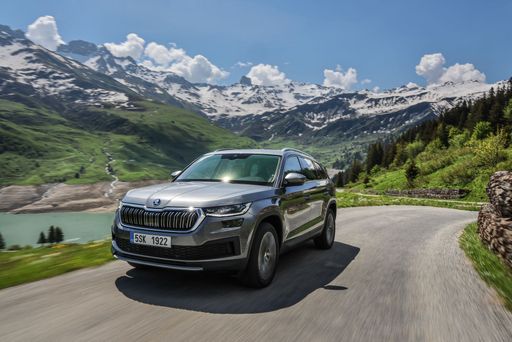 @ Škoda Auto a.s. / Škoda Storyboard
@ Škoda Auto a.s. / Škoda Storyboard
Skoda Kodiaq
Ford Kuga
The Kuga is Ford’s adaptable family SUV that blends usable space with a surprisingly lively driving character, making daily commutes and weekend escapes equally enjoyable. With smart interior packaging, an easy-to-use infotainment setup and composed road manners, it’s a sensible choice for buyers who want a bit of fun without the fuss.
details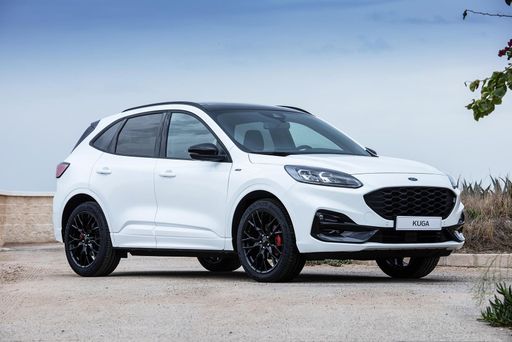 @ Ford Motor Company / Ford Media Center
@ Ford Motor Company / Ford Media Center
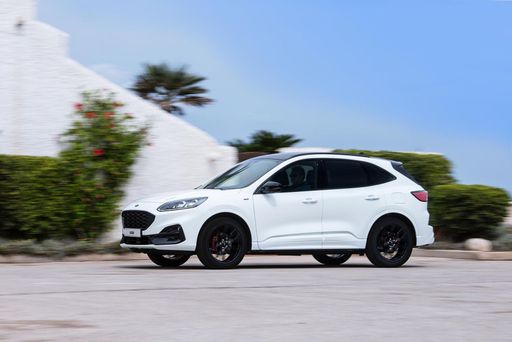 @ Ford Motor Company / Ford Media Center
@ Ford Motor Company / Ford Media Center
 @ Ford Motor Company / Ford Media Center
@ Ford Motor Company / Ford Media Center
Skoda Kodiaq
The Skoda Kodiaq blends sensible practicality with surprising style, so families and weekend adventurers get roomy comfort without looking like a moving van. It feels calm and composed on the road, packs clever storage and user-friendly tech, and manages to deliver a near-premium vibe without the pretension.
details @ Škoda Auto a.s. / Škoda Storyboard
@ Škoda Auto a.s. / Škoda Storyboard
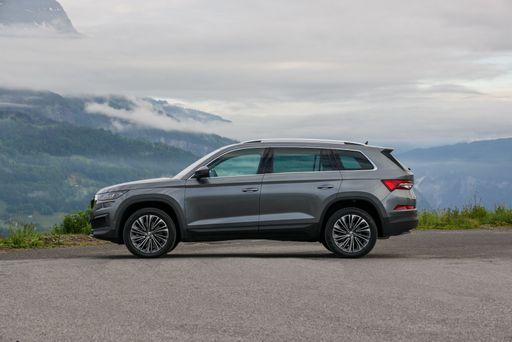 @ Škoda Auto a.s. / Škoda Storyboard
@ Škoda Auto a.s. / Škoda Storyboard
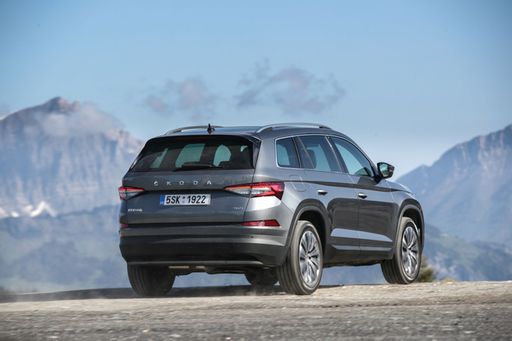 @ Škoda Auto a.s. / Škoda Storyboard
@ Škoda Auto a.s. / Škoda Storyboard
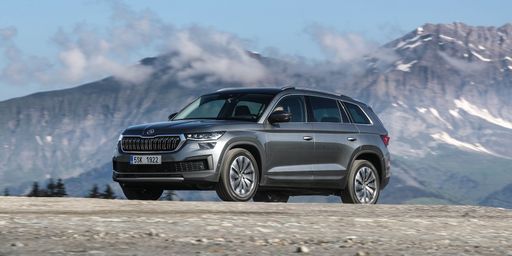 @ Škoda Auto a.s. / Škoda Storyboard
@ Škoda Auto a.s. / Škoda Storyboard
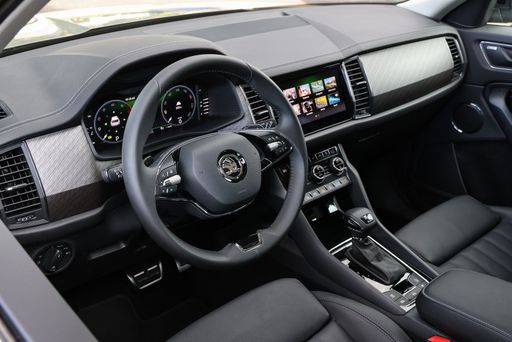 @ Škoda Auto a.s. / Škoda Storyboard
@ Škoda Auto a.s. / Škoda Storyboard
 @ Ford Motor Company / Ford Media Center
@ Ford Motor Company / Ford Media Center
|
 @ Škoda Auto a.s. / Škoda Storyboard
@ Škoda Auto a.s. / Škoda Storyboard
|
|
|
|
Costs and Consumption |
|
|---|---|
|
Price
34200 - 46300 £
|
Price
36800 - 49600 £
|
|
Consumption L/100km
2.8 - 6.8 L
|
Consumption L/100km
0.4 - 8.2 L
|
|
Consumption kWh/100km
-
|
Consumption kWh/100km
-
|
|
Electric Range
68 km
|
Electric Range
113 - 123 km
|
|
Battery Capacity
1.1 - 14.4 kWh
|
Battery Capacity
19.70 kWh
|
|
co2
55 - 154 g/km
|
co2
9 - 186 g/km
|
|
Fuel tank capacity
42 - 54 L
|
Fuel tank capacity
45 - 58 L
|
Dimensions and Body |
|
|---|---|
|
Body Type
SUV
|
Body Type
SUV
|
|
Seats
5
|
Seats
5
|
|
Doors
5
|
Doors
5
|
|
Curb weight
1526 - 1859 kg
|
Curb weight
1684 - 1970 kg
|
|
Trunk capacity
412 L
|
Trunk capacity
745 - 910 L
|
|
Length
4604 - 4645 mm
|
Length
4758 - 4761 mm
|
|
Width
1882 mm
|
Width
1864 mm
|
|
Height
1673 - 1681 mm
|
Height
1663 - 1683 mm
|
|
Max trunk capacity
1534 L
|
Max trunk capacity
1945 - 2105 L
|
|
Payload
541 - 550 kg
|
Payload
460 - 563 kg
|
Engine and Performance |
|
|---|---|
|
Engine Type
Petrol, Full Hybrid, Plugin Hybrid
|
Engine Type
Plugin Hybrid, Petrol, Petrol MHEV, Diesel
|
|
Transmission
Manuel, Automatic
|
Transmission
Automatic
|
|
Transmission Detail
Manual Gearbox, CVT, Automatic Gearbox
|
Transmission Detail
Dual-Clutch Automatic
|
|
Drive Type
Front-Wheel Drive, All-Wheel Drive
|
Drive Type
Front-Wheel Drive, All-Wheel Drive
|
|
Power HP
150 - 243 HP
|
Power HP
150 - 265 HP
|
|
Acceleration 0-100km/h
7.3 - 9.9 s
|
Acceleration 0-100km/h
6.3 - 9.7 s
|
|
Max Speed
195 - 200 km/h
|
Max Speed
205 - 231 km/h
|
|
Torque
240 Nm
|
Torque
250 - 400 Nm
|
|
Number of Cylinders
3 - 4
|
Number of Cylinders
4
|
|
Power kW
111 - 178 kW
|
Power kW
110 - 195 kW
|
|
Engine capacity
1496 - 2488 cm3
|
Engine capacity
1498 - 1984 cm3
|
General |
|
|---|---|
|
Model Year
2025
|
Model Year
2024 - 2025
|
|
CO2 Efficiency Class
E, D, B
|
CO2 Efficiency Class
B, F, G, E
|
|
Brand
Ford
|
Brand
Skoda
|
What drivetrain options does the Ford Kuga have?
The Ford Kuga is available as Front-Wheel Drive or All-Wheel Drive.
The prices and data displayed are estimates based on German list prices and may vary by country. This information is not legally binding.
